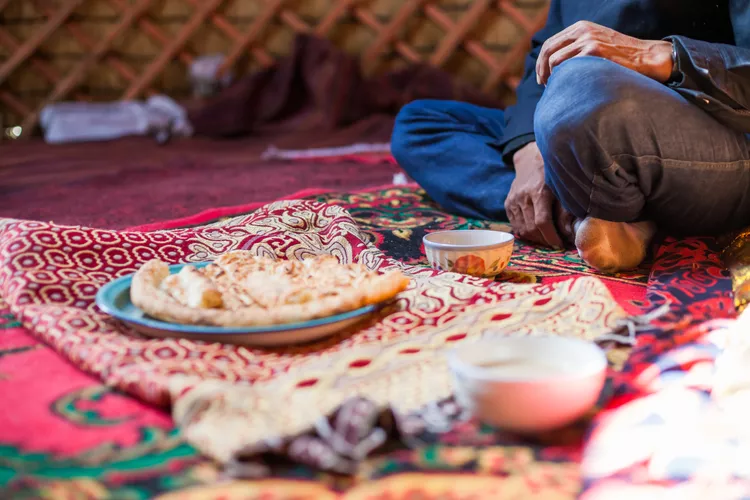Summary of the Culinary Delights in Xinjiang
The food you’ll find in the Xinjiang region is quite different from that of the rest of China. Here’s a quick primer on the kinds of things you’ll come across while you travel.
01. Pomegranates

Pomegranates are in season during the late summer and fall months. Piled high in markets, they are sold by the kilo. One of my favorite fruits, I was delighted to find the stunning dark red variety. Our guide from Old Road Tours informed us there are two types of pomegranate – sour for cooking and sweet used for juice. It can be difficult to discern the difference.
I bought an enormous box at a market in Kashgar and carried them throughout my trip via Urumqi and Turpan, ultimately bringing them home to Shanghai. I was exceptionally pleased with my choice. After a few days when they were all gone, I even tried to reorder Kashgar pomegranates online, yet they weren’t quite as delightful.
02. Naan Flatbread

This flatbread is widely available throughout the region from small bakers. Best enjoyed warm from the naan oven, it is a breakfast staple. Some are made plain, while others incorporate cumin, salt, scallions, or sesame seeds. The bread is often decorated with traditional circular patterns.
03. Leghman Noodles

The Xinjiang style of traditional “lamian” is known as leghman. Prepared by hand, these noodles are first boiled then topped with a stir-fry of diverse ingredients based on regional variations. The typical topping comprises vegetables such as tomatoes, peppers, onions, potatoes, and beans. Instead of being served in soup, they are cooked and combined with the vegetable medley.
This noodle dish is commonplace in Xinjiang and can be found in most local eateries.
04. Polu Rice Pilaf

A highly recognizable dish, polu, or rice pilaf, is often prepared outside restaurants using large wok-like pans. This dish typically combines mutton, onions, and yellow carrots, a variety only found in Xinjiang. The ingredients are seasoned with spices like cumin and steamed together with rice. Occasionally, raisins are included, providing a delightful salty-sweet flavor. This dish is convenient to take away if you’re short on time, as most vendors will package it for you.
05. Lamb and Mutton Skewers

Kawaplar are a common sight at markets, skewers primarily made of mutton and mutton fat. Outside the market, you’ll find a line of vendors grilling these skewers over charcoal, creating a delicious smoky aroma. Each vendor usually has a small table with a pile of pre-grilled skewers and a large fan blowing away charcoal smoke, which may get blown towards you if you’re not careful.
These skewers are typically seasoned with a spice mix that contains cumin and hot chili flakes. If you prefer less spice, be clear during your order.
06. Stewed Chicken

A very common dish in Xinjiang-style eateries features stewed chicken paired with potatoes and green peppers. Be cautious, as the chicken may not be de-boned.
07. Raisins

Xinjiang is renowned for its abundance of fruit, particularly as the leading producer of grapes and grape-based products, including raisins. Various raisin types populate the markets, with dedicated sections set aside for dried fruit vendors.
Our guide from Old Road Tours indicated that if you seek natural raisins, you should avoid those which appear overly appealing! Preference here lies with smaller, darker-colored raisins that seem less perfect, as these are likely dried naturally without chemicals.
Raisins make an excellent souvenir for friends and family back home.
08. Samsa Mutton Dumplings

Among the most delicious offerings encountered in Xinjiang are street-side Samsa. Baked in a traditional oven resembling those used for naan, these dumplings are filled with a savory mix of mutton and onion. We savored them straight from the oven, experiencing their delightful freshness.
09. Nuts and Dried Fruits

Markets and street vendors offer a variety of dried fruits and nuts for sale. Familiar options include almonds, cashews, and dried apricots. However, be cautious, as we once mistook apricot seeds for mini-almonds and were surprised to find they are quite bitter. Most vendors are accommodating and allow sampling of their products prior to purchase. Throughout our journey, we constantly enjoyed a supply of almonds, dried apricots, raisins, and cashews.





